
by Bryan Jáuregui | Adventure, Blog, Conservation, Featured Home Blog, Whales, Wildlife
It’s the time of year when droves of homo sapiens inhabiting the upper section of the North American continent give themselves over to the irrepressible urge (what scientists might call a life-preserving instinct) to seek out the warm sand and cool vibes of Baja California Sur. Following the great highway routes mapped out by their ancestors, they migrate south in their Volkswagen campers, Airstreams, and Harleys, the miles made short and their dreams made large by the great beach music of their elders. When they arrive there is much feasting and celebrating (in a greatly reduced version of their native garb) as they share stories of their great migrations, some of which are over 4,000 miles long!

The neighbors are unimpressed. Take the North Pacific loggerhead sea turtle (Caretta caretta) for example. These loggerheads begin life on the shores of Japan, and many appear content to spend the balance of their days foraging for crab, jellyfish and other delicacies in the central Pacific. But just as with our homo sapiens, there are some outliers among the loggerheads who feel the irresistible pull of Baja California Sur, and swim 9,000 miles (14,500 km) to the waters of Baja in nothing more than the shell they were born in. Being cold-blooded, loggerheads need warm water to survive, yet this epic journey requires them to pass through 6,000 kilometers of water between Pacific basins that is so cold that Charles Darwin himself pronounced it “impassable” for the likes of sea turtles. Many species, like coral, are unable to cross this divide, yet a small group of loggerheads regularly makes the trip.
For years this feat remained a mystery, with scientists simply unable to account for the Japanese-born loggerheads showing up in the abundant feeding grounds of Baja. Then they got focused, and between 1997 and 2013 researchers in Japan and the US tagged hundreds of adolescent loggerheads and published their findings in April 2021. It turns out that the young loggerheads migrate in the years when the ocean surface temperature is much warmer than usual due to natural phenomena such as marine heat waves and El Niño. These conditions create a thermal corridor that allows the young turtles to keep swimming in warm water all the way to Baja. Mystery solved!
But what prompted the scientists to get focused? Adelita of course. Adelita was a loggerhead turtle who was captured off the coast of Baja as a juvenile and raised in captivity. She was released in 1996 with a satellite tag attached to her back, and proceeded to amaze the world by traveling over 14,000 kilometers across the Pacific Ocean, becoming the first animal to cross an ocean basin while being tracked. It was Adelita who confirmed to scientists that the loggerheads seen in Japan, the central Pacific and Baja all belong to the same distinct population. It was Adelita who led to the knowledge that this population nests exclusively in Japan then spreads out across the Pacific to forage for food. It was Adelita whose journey prompted insight into the bold loggerheads who spend their youth in the blissfully warm, food-rich waters of Baja, then return to Japan at 20-30 years of age to continue the species. It was Adelita who transformed loggerheads into the stuff of migration legend.
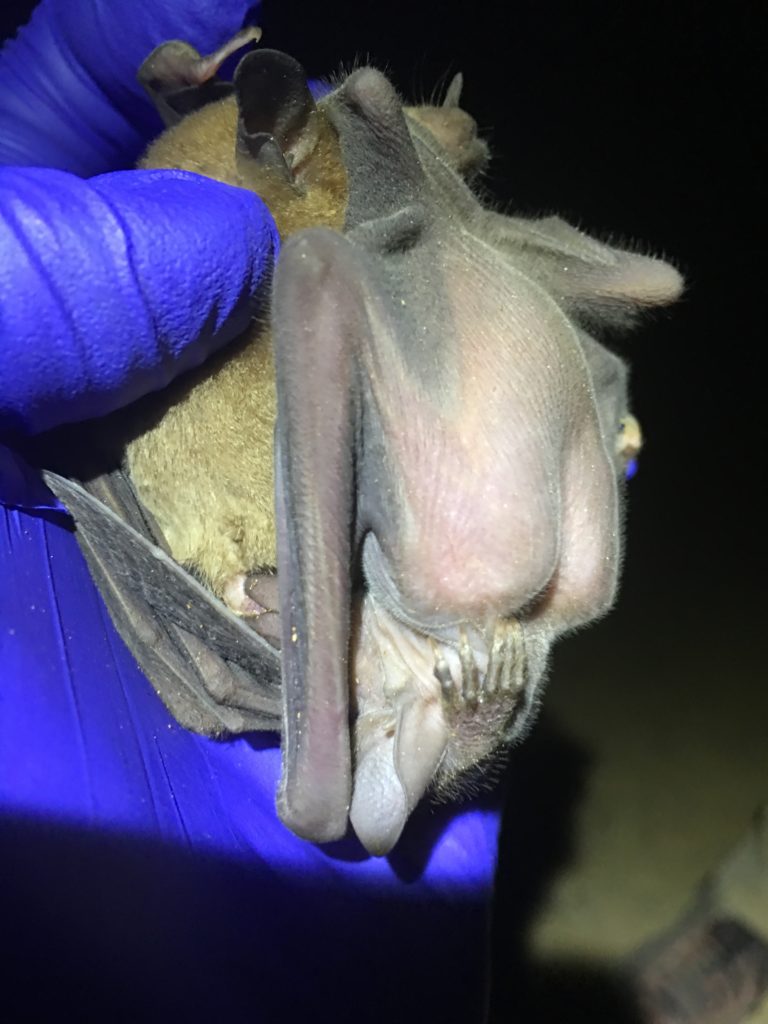 For its part, the lesser long-nosed bat (Leptonycteris yerbabuenae) may migrate only a few hundred miles each year from south-central Mexico to Baja California Sur, but the females of the species up the ante by doing it while heavily pregnant. According to Dr. Winifred Frick who has studied the bats of Baja for almost two decades, “In late March and early April the females follow the nectar corridor north from southern-central Mexico up along the Sinaloan coast, and we think they likely fly over the Sea of Cortez to the Baja peninsula. The lesser long-nosed bats are in the last stages of pregnancy when they make these spring migrations. Their feat is made all the more incredible when you realize that bat pups are roughly a third of the mother’s weight at birth – an enormous amount of extra baggage to carry on the migration route. The females then all give birth at the same time in mid-April in what is known as a synchronous birth pulse.” (It is generally acknowledged as a blessing that the migratory homo sapiens do not follow suit.) The babies nurse for 4-8 weeks, during which time it is not unusual for the mothers to fly 60 miles in each direction, each night, to their feeding grounds to obtain the nutrition needed for both mother and pup. Dr. Frick puts this feat into human terms. “It would be like leaving your newborn at home, jogging 60 miles to find a pop-up grocery store, eating all your meals at once, then jogging 60 miles home to your newborn.” In the process of feeding, the lesser long-nosed bats act as major pollinators for Baja California’s agaves and columnar cacti. When the cacti are pollinated and the babies are weaned, the cloud of bats then migrates back to the Mexican mainland. A very satisfactory migration job completed!
For its part, the lesser long-nosed bat (Leptonycteris yerbabuenae) may migrate only a few hundred miles each year from south-central Mexico to Baja California Sur, but the females of the species up the ante by doing it while heavily pregnant. According to Dr. Winifred Frick who has studied the bats of Baja for almost two decades, “In late March and early April the females follow the nectar corridor north from southern-central Mexico up along the Sinaloan coast, and we think they likely fly over the Sea of Cortez to the Baja peninsula. The lesser long-nosed bats are in the last stages of pregnancy when they make these spring migrations. Their feat is made all the more incredible when you realize that bat pups are roughly a third of the mother’s weight at birth – an enormous amount of extra baggage to carry on the migration route. The females then all give birth at the same time in mid-April in what is known as a synchronous birth pulse.” (It is generally acknowledged as a blessing that the migratory homo sapiens do not follow suit.) The babies nurse for 4-8 weeks, during which time it is not unusual for the mothers to fly 60 miles in each direction, each night, to their feeding grounds to obtain the nutrition needed for both mother and pup. Dr. Frick puts this feat into human terms. “It would be like leaving your newborn at home, jogging 60 miles to find a pop-up grocery store, eating all your meals at once, then jogging 60 miles home to your newborn.” In the process of feeding, the lesser long-nosed bats act as major pollinators for Baja California’s agaves and columnar cacti. When the cacti are pollinated and the babies are weaned, the cloud of bats then migrates back to the Mexican mainland. A very satisfactory migration job completed!
Given their enormous size and intelligence, it may not seem fair to bring gray whales (Eschrichtius robustus) into the Baja migration discussion. After all, over the average gray whale’s lifetime of annually migrating the roughly 12,000 miles roundtrip between the feeding grounds of the Arctic and the breeding grounds of Baja, they will have traveled the equivalent of a return trip to the moon. But the gray whales aren’t resting on their migratory laurels. In 2010 a gray whale showed up off the coast of Israel, then moved on to Spain before dropping off the scientific radar. Three years later a different gray whale swam the longest distance ever recorded in a marine vertebrate, more than 16,700 miles, lingering off the coast of Namibia for a bit before vanishing to parts unknown. (A leatherback turtle had previously held the world record of 12,774 miles across the Pacific. She couldn’t be reached for comment for this article.) National Geographic reports that scientists were so discombobulated by seeing gray whales on the wrong side of the world – they had never seen one outside of the Pacific Ocean before – that one compared the feeling to walking down a street in California and seeing a giraffe.
But these two whales just might just be the vanguard in a new migratory pattern for gray whales. Or, more precisely, the dusting off of an old one. Research suggests that millions of years ago gray whales lived in both the Atlantic and Pacific. The planet later cooled and an impenetrable Arctic barrier formed between the two populations, which then may have evolved into two distinct species. If so, then it is likely that the Atlantic gray whales are what naturalists of the 18th century called “scrag whales” and that they were decimated by the whaling industry while the Pacific whales survived. DNA and carbon isotopes from the bones of Atlantic whales proved to scientists that the Pacific and Atlantic gray whale populations are still closely related. In fact, it shows that the Pacific gray whale was responsible for colonizing the Atlantic Ocean, not just in a one-off, fluke event, but several times across the ages. As National Geographic puts it, the data proves that “Pacific gray whales have periodically swum across the Arctic Ocean and into the Atlantic and established populations that survived for millennia. The scientists can identify several waves of immigration. One took place about 79,000 years ago, and then three others happened more recently, between about 10,000 and 5,000 years ago.”
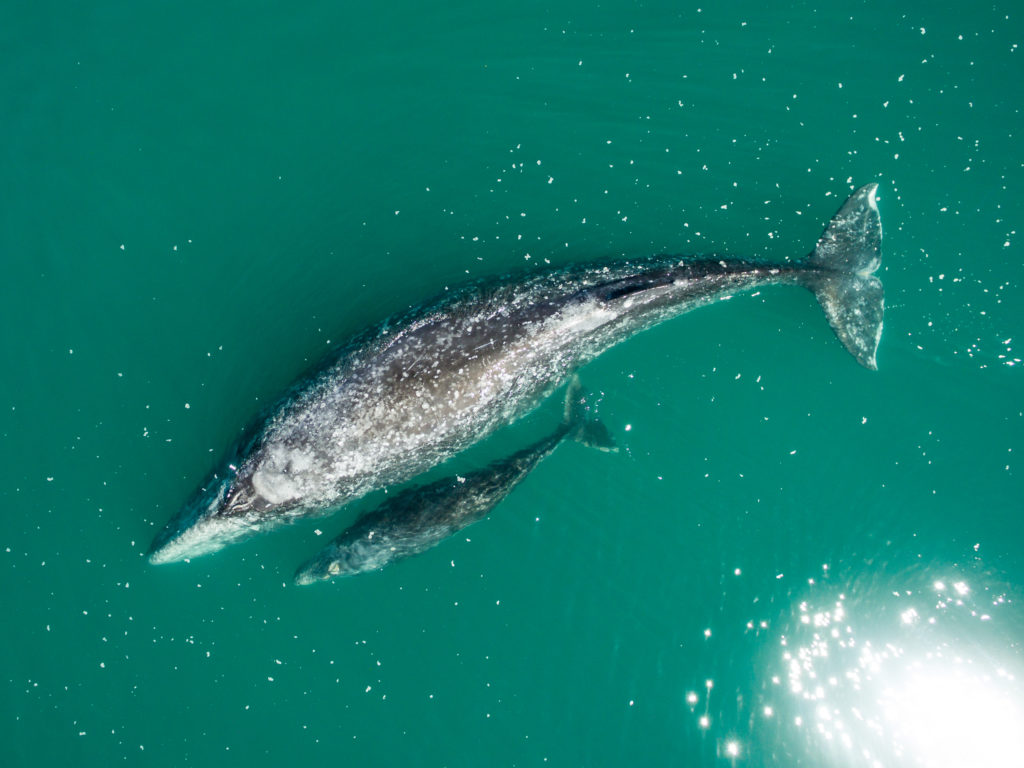
The loggerheads know how they did it: warm water, at least relatively speaking. 70,000 to 135,000 years ago the climate was so warm that the Arctic Ocean was open all year round, allowing the Pacific gray whales to freely migrate to the Atlantic. A new ice age cut off the Arctic once again, but when it ended 60,000 years later the Pacific gray whales renewed their Arctic passages to the Atlantic. A later cooling again closed the route, but now that the migrating homo sapiens are warming up the Arctic in record time, perhaps more gray whales will follow the lead of their friends spotted in Israel and Namibia, and strike out across the ice-free Arctic Ocean, looking to colonize the Atlantic once again.
Migrations long and short are a theme of life in Baja. In March and June thousands of mobula rays congregate to mate in the Sea of Cortez bays around La Paz and La Ventana, then migrate over 300 miles to the Pacific side of the peninsula. In spring and autumn each year the small Red Knot bird (Calidris canutus roselaari) follows the Pacific Flyway 9,300 miles from the Arctic to Tierra del Fuego – then back again – bulking up on nutritious grunion eggs along the Sea of Cortez each way. No matter the species or their origin, the migrators are part of the magic pull and thrill of Baja as we marvel at and celebrate their victories over incredible obstacles to reach the peninsula’s life-giving shores. As Thoreau may have mused, the homo sapiens who migrate to Baja may find that it is not the margarita they sought but the tonic of wildness they found of which they can never have enough. And that is as life-affirming a reason for migration as ever there was.
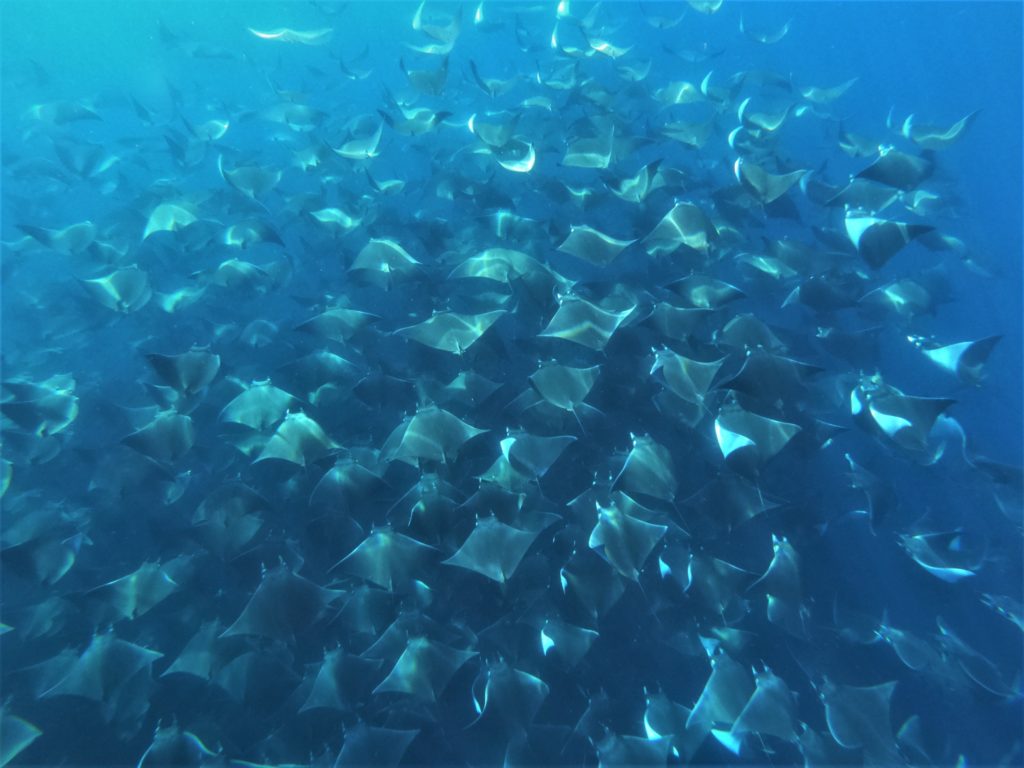
Notes:
- Thanks to Jose Sanchez of PureBajaTravels.com for inspiration on gray whale travels through the Arctic.
- Details on the scientific research related to gray whale migrations across the Arctic came from Carl Zimmer’s article in National Geographic, Whales on the Wrong Side of the World.
- The Stanford study on loggerhead turtle migrations was originally published in Frontiers of Marine Science.
Todos Santos Eco Adventures (TOSEA) is the leading eco adventure company in Baja California Sur. TOSEA invites you to join them in the following initiatives to help preserve the habitats of Baja California that both our native and migratory species depend on:
Carbon Capture with Tomorrow’s Air. TOSEA is a carbon capture education partner with Tomorrow’s Air, and to date has supported the removal of one ton of carbon dioxide from the air. All homo sapiens who migrate to Baja are invited to join TOSEA in supporting this incredible project that was awarded Newsweek’s 2021 Future of Travel Award in the Visionary category
– it is not carbon offset, it is actually removing CO2 from the air and storing it deep underground. www.tomorrowsair.com.
Zero Waste Alliance of Todos Santos and Pescadero (ZWA). TOSEA is a proud supporter of the ZWA which is actively working to reduce the amount of waste that goes to the local landfill and build circular economies around that waste. All homo sapiens, both native and migratory, are invited to join the movement! www.facebook.com/alianzacerobasuratodossantos
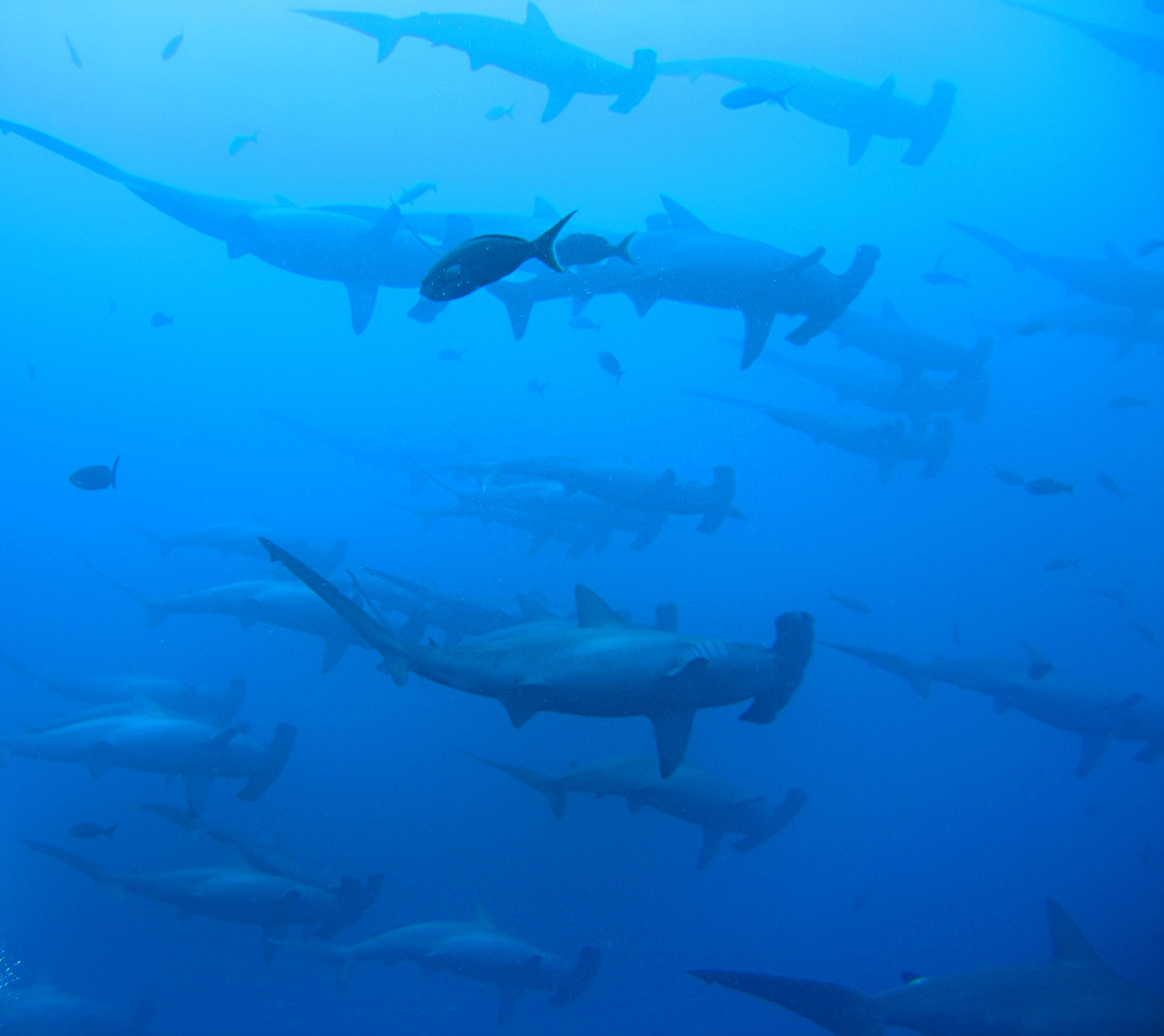
by Bryan Jáuregui | Adventure, Blog, Conservation, Wildlife
by Bryan Jauregui, Todos Santos Eco Adventures

Hammerheads in the Sea of Cortez by Kaia Thomson
When Dr. Peter Klimley, AKA Dr. Hammerhead, was studying the scalloped hammerheads of El Bajo seamount near La Paz in the late 1970s, he attached little compass sensors to some of the sharks and made an amazing discovery. “The sharks were swimming like we would drive a car down the highway, directly from one point to another.”
The sharks would leave El Bajo seamount, go out for 10 miles or more in the middle of the night, and return in the morning with no problem at all. How could they do that? Two things. Firstly, the Gulf of California is filled with magnetic fields of lava flows around seamounts, and the sharks use the magnetic fields to navigate, like following neon signs along the highway. Secondly, the whacky shape of the hammerhead’s head means that the shark’s sensors, known as ampullae of Lorenzini, are spaced widely apart over a larger surface so the sharks can better detect variations in the magnetic field, reading the lava flows as clearly as a white line down the highway.
The result, demonstrated by Klimley and published by National Geographic, is that hammerheads are using seamounts alike El Bajo as hook-up joints along established migration routes. Interestingly, the vast majority of the sharks gathering at the seamounts are female, and Klimley found that they are fighting each other to establish dominance as the males prefer to mate with the strongest females. 400 million years of evolution at your service ma’am!
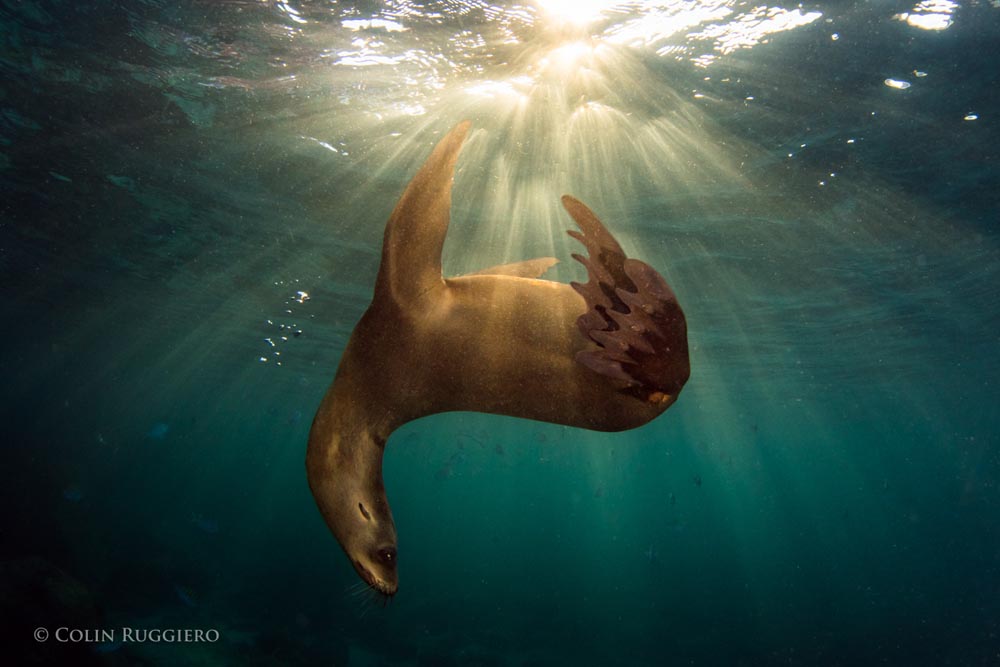
by Bryan Jáuregui | Adventure, Blog, Conservation, Homepage, Wildlife
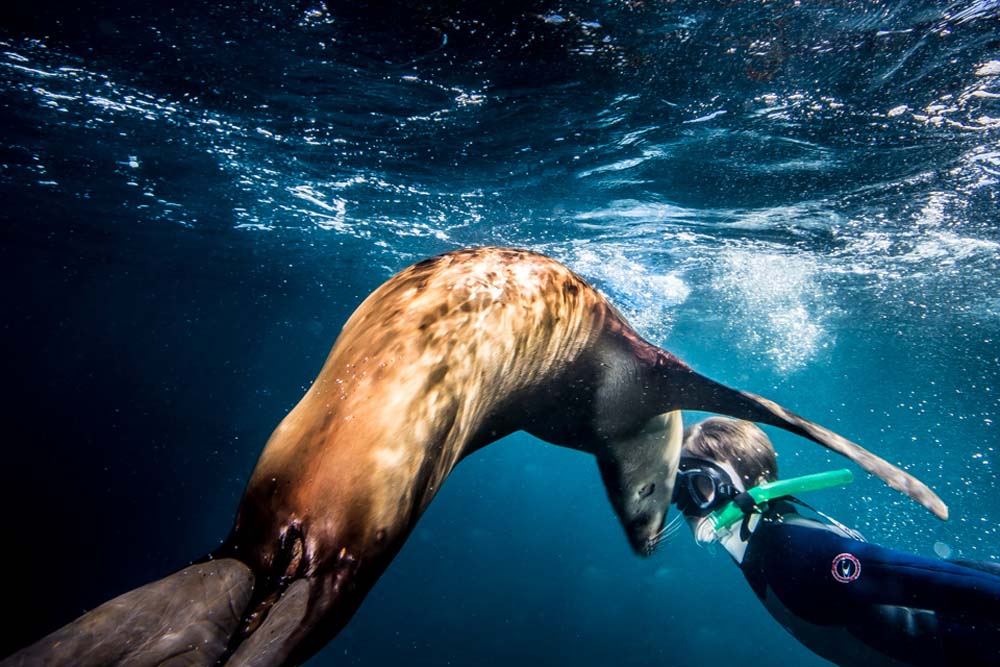
Photo by Erika Peterman
by Bryan Jáuregui for the Journal del Pacifico
Swimming with the sea lion puppies at Los Islotes, the southernmost rookery of the California Sea Lion, Zalophus californianus, is truly one of life’s great joys. The puppies are often playful and naughty, nibbling on the flippers and fingers of human visitors, while their teenage siblings like to sidle up to humans for a good belly rub or game of chase. Their mothers may be found sunning themselves on the rocks, enjoying a snooze, while the males who rule the 20 territories of Los Islotes indefatigably patrol the waters to ensure everyone’s safety. It is a scene of utter Baja bliss, and humans can’t help but feel a magical glow from this most wondrous of wildlife encounters.
All of which begs the obvious question: Why are the males working so hard when everyone else is just having a good time?
Claudia J. Hernandez-Camacho, a professor of biology at CICIMAR in La Paz, has been studying the sea lions of Los Islotes and the Sea of Cortez since 1990. In particular, she has studied the entire lifespan of 190 sea lion individuals (94 females, 96 males) who were hot-branded by her professor between 1980 and 1984. Her findings, based on these specific sea lions and others, tell a complicated tale for our pinniped friends.
“Sea lions are polygynous, meaning that one male mates with several females in the territory that he defends on land and sea. It takes an enormous amount of energy to defend this territory, and in the breeding season a territorial male, who is so focused on his job that he barely eats or sleeps, can lose up to 30% of his impressive body weight (400 to 500 kilos, or about a ton) in just a few weeks.”
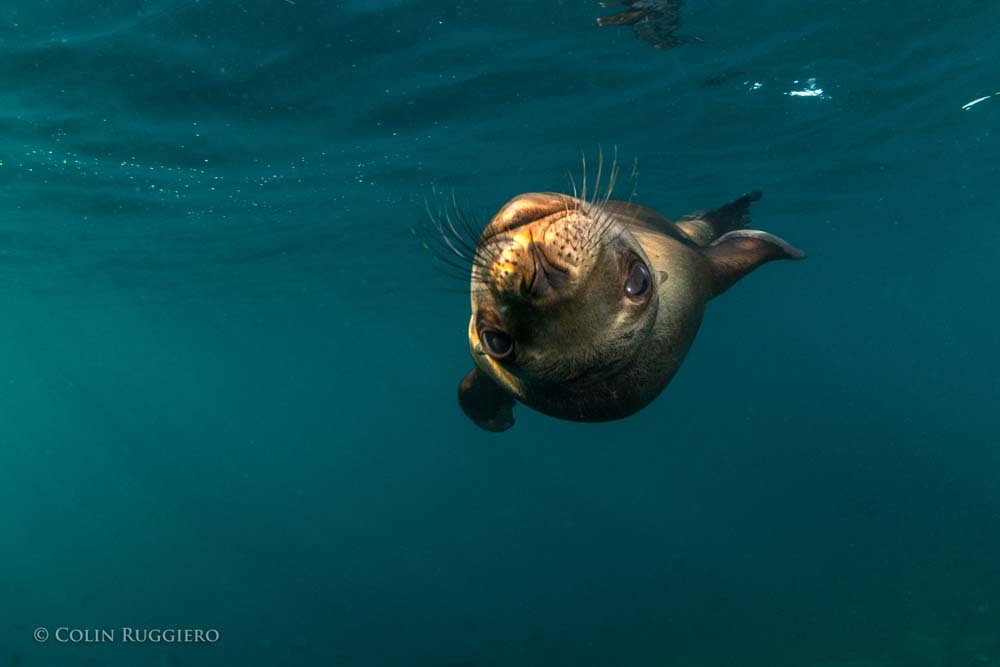
Photo by Colin Ruggiero for Todos Santos Eco Adventures
One would assume, of course, that the males are spending this incredible amount of energy to defend their harems and offspring, to ensure the survival of their genes. “But this is not exactly the case” says Claudia, “they are defending the territory, not the females.” The science proves this out. “Genetic studies show that just 15% of territorial males are the fathers of the newborns the next breeding season. It is not just that the females hook up with and get impregnated by wandering, opportunistic males when they slip off for their 4-5 day feeding trips, which they do, but in some cases the territorial males are not even copulating with the females in their territory.” All that work and no sex?
“It’s a little more complicated than that,” says Claudia. “There are 600 individual sea lions at Los Islotes, and every year around 170 pups are born. Almost 30% of the pups die in the first two years, either from disease or because they or their mothers have fallen prey to predators. But that means that 70% are surviving. With this type of situation, many of the sea lions are, by definition, related. It could be argued that the Los Islotes males work so hard not just for their own offspring, but because they are protecting their extended families. This would also explain why they do not copulate with all the females in their territory. They are avoiding inbreeding.” This is an approach to collective living that we generally only associate with high intelligence mammals like primates, elephants and dolphins.
The Los Islotes territorial males are so successful in their defense of the colony, and have made conditions so conducive to survival, that Los Islotes is actually full to capacity now. In fact, two new satellite colonies have been created nearby in recent years by all the young males who are no longer welcome at Los Islotes, but who are still too young and slight to fight older, larger males for territory. Sea lions are philopatric, meaning that they stay in or habitually return to the area of their birth, so it is possible that these satellite colonies will only continue to grow.
What makes this all the more remarkable is that it is happening at a time when the overall population of California Sea Lions in the Sea of Cortez is dropping dramatically. Between 2000 and 2018, 40% of the population of other colonies disappeared. Are those males falling down on the job? Not likely says Claudia. “We are analyzing a lot of
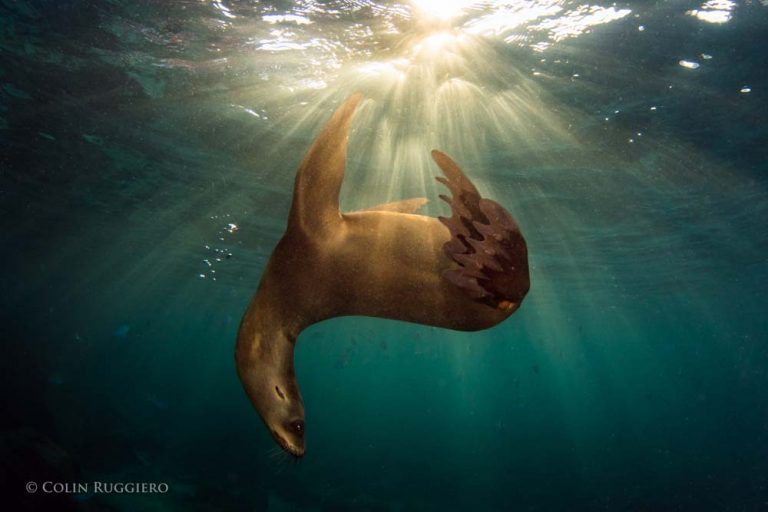
Photo by Colin Ruggiero for Todos Santos Eco Adventures
environmental variables right now to determine the main factor causing the decline of these colonies, but one of the most likely culprits is the food supply” she observes. “It is not that the fish populations in the other parts of the Sea of Cortez are declining, they are not. It is that the fish are moving further south. While the sea lions of Los Islotes, the southernmost California Sea Lion rookery, are benefitting from this trend, it is proving lethal to others. Healthy females will travel up to 60 kilometers away from their colonies to find food, but further than that is not feasible. They need to conserve energy to produce milk for their pups. And even in those more northern locations where there are still fish, there are a very limited number of fish species, and this relatively poor-quality diet means that the females are not gaining enough energy from their food to productively nurse their pups. On the opposite side of the coin, the sea lions of Los Islotes are getting an increasing number of fish species in their diet, with the result that population density has reached an all-time high.”
Female sea lions are not only philopatric, i.e., prone to stay in the area where they were born, they are attached to very specific real estate in that area, with many staking one specific rocky outcropping for their own. So with the increasing density of the population at Los Islotes, it is not surprising to learn that sea lion attitudes are becoming a bit more aggressive. Add to that the fact that the entire colony of females either a) goes into estrus, or b) has newborn pups to defend at exactly the same time and breeding season, which generally takes place June 1 to August 31, becomes a time when human body parts might best be kept at a distance from the sea lions of Los Islotes. In fact, Los Islotes is now closed to snorkelers and scuba divers during this period.
Los Islotes is regularly listed as one of the top diving/snorkeling spots in the world, and Claudia and her students are launching a study to evaluate the effects of all these visitors on the sea lions. The tourism hiatus being imposed by the authorities during breeding season offers them the perfect opportunity for their research. “We have already collected fecal samples from the sea lions during the tourist season, and will now do so again when the colony is closed to tourists. We will then test the level of cortisol, a stress indicator, in both sets of fecal matter to determine if tourism increases stress in sea lions. We have already observed some differences in behavior in the sea lions at Los Islotes. While at other, more remote colonies, the sea lions will copulate during the day, at Los Islotes they only engage in this behavior at night. We hope to be able to determine if tourism is having an impact on the sea lions.”
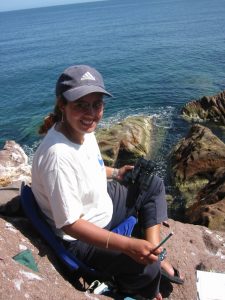
Claudia at Los Islotes
Of course, liking your loving in the evening time is a common enough attribute of many healthy mammals, but if other colonies are also enjoying some afternoon delight, have the sea lions of Los Islotes gone too far in adapting to the presence of humans? Will the territorial males one day snap back to impose a more natural environment for their territories? Human males have certainly done battle over lesser issues.
Tourists have been visiting Los Islotes on a regular basis for roughly three decades, and sea lion males live an average of 19 years. There is therefore not yet a deep institutional knowledge about humans among the territorial males, and they could still be giving us the opportunity to demonstrate our worthiness as visitors to their home. Will we make the cut? We can’t be sure what the sea lions have learned about humans over the years, or what Claudia and her team will demonstrate, but the strong pull of Los Islotes on humans is easy enough to understand: it is a place where joy and spontaneity rule, and we thrill to that vibrancy. While the territorial males are likely not motivated by their roles as life coaches for humans, it is enticing to think that maybe just one of the reasons they work so hard is to protect such a joyful lifestyle for their families. Claudia and her team are working hard to do the same.
VISIT WITH CLAUDIA AND HER TEAM!
Todos Santos Eco Adventures is the leading eco adventure company in Baja California Sur. On Isla Espiritu Santo we operate Camp Cecil, a luxury tent camp, and Camp Colossus, a moveable glamping operation. Claudia and her students will be spending time with us at our camps throughout the season as they conduct their sea lion research, so you may find them at the dinner table if you spend time with us at the island!
© Copyright Sergio and Bryan Jauregui, Casa Payaso S de RL de CV, 2018
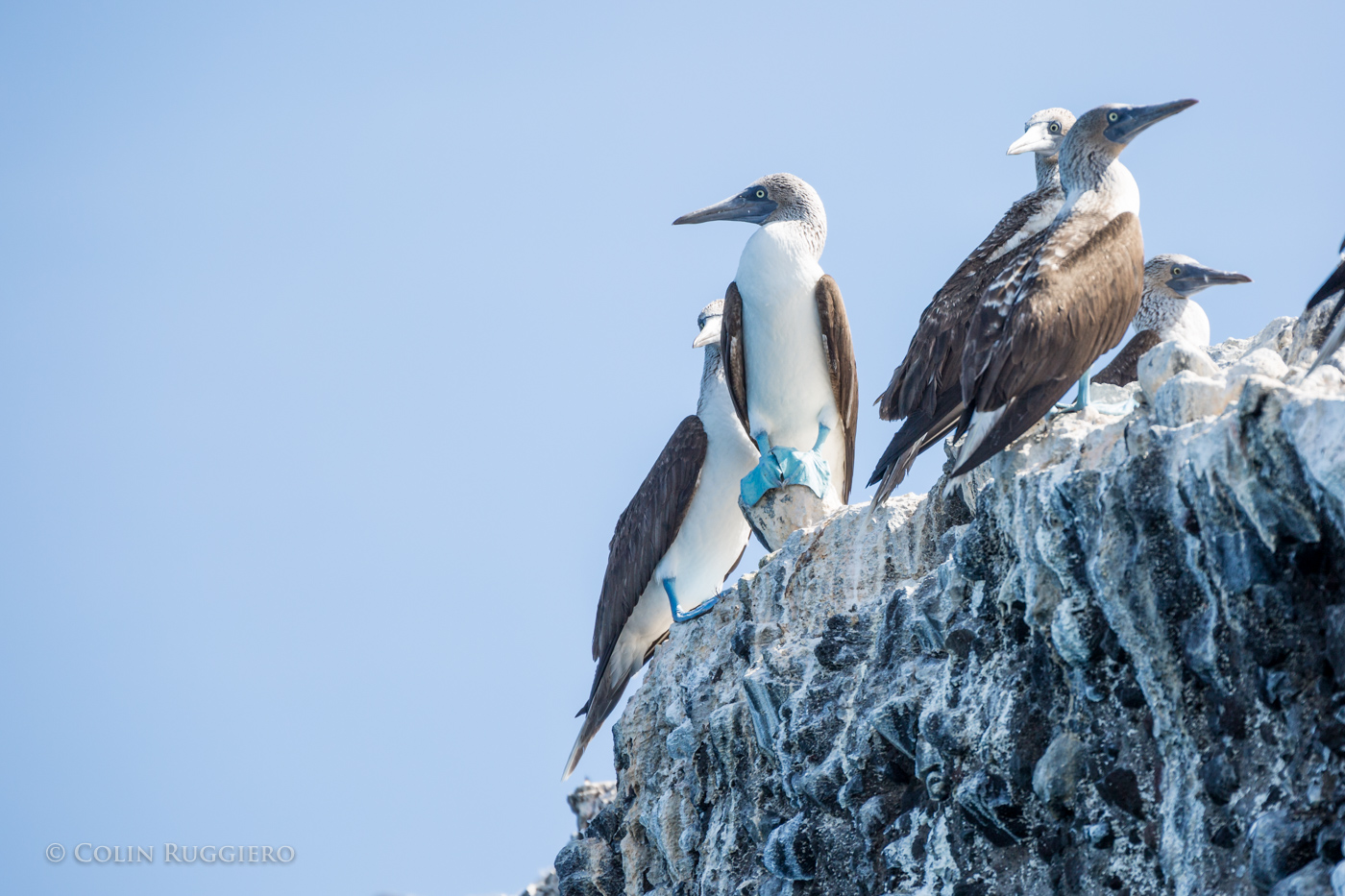
by Bryan Jáuregui | Blog, Homepage, Wildlife
by Bryan Jáuregui, Todos Santos Eco Adventures
This article was originally published in Janice Kinne’s Journal del Pacifico
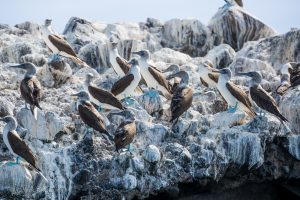
Blue-footed Boobies at Isla La Gaviota in the Sea of Cortez. Photo by Colin Ruggiero
At a time when over half the single people in the Americas have created an online dating profile through which they send out their virtual avatars to court potential partners, it may be difficult to remember the days of Saturday Night Fever and Strictly Ballroom when plumage and dance moves were everything. But off the coast of Baja California Sur on islands like La Gaviota, Isla Isabel, and Isla San Pedro Mártir, dancing to show off mating suitability is alive and well, although the practitioners looked so silly to early outside observers that they earned themselves the name of Booby, from the Spanish word bobo meaning “stupid” or “clown”. Pretty much your worst dancing-in-public nightmare.
But the Blue-footed Boobies of Baja remain unruffled, secure in the knowledge that shaking their tail feathers has resulted in what is possibly the largest Blue-footed Booby colony in the world. And it’s not just the moves that are important in their dance, but the exact cerulean hue the footwork displays. Blue-footedness, it turns out, is enhanced by the bright yellow pigments found in the carotenoids of the fish the birds consume, so those who catch and eat more fish get bluer feet. Ipso facto bluer feet connote better health, better health connotes greater ability to provide for a nest, and as every dancer in life thinking about raising a chick knows, those are the moves that really count in a mate. So the booby dance includes a series of steps in which the feet are raised up to allow potential partners to inspect their blue-ness (apparently a vibrant aquamarine is the most desirable) and determine if that’s the blue they want to get tangled up in. And unlike in some species in which only the male sports the color, in boobies both sexes are focused on the blue tones of a potential partner’s feet. In fact, males will avoid mating with females whose blue feet have been dulled with paint. With boobies, it definitely takes two to tango.
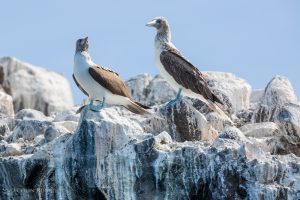
Blue-footed Boobies. Photo by Colin Ruggiero
And in many cases, three. Researchers have found that Blue-footed Booby rookeries could easily provide source material for the most salacious telenovelas; in over 50% of booby couples one or both partners engage in what scientists call extrapair behavior (what the rest of us would call an extramarital affair), and it is not at all uncommon for a booby to toddle off for a quickie with the neighbor while its mate is out foraging at sea. Dr. Hugh Drummond, Professor of Biology at the National Autonomous University of Mexico (UNAM), who has studied the Blue-footed Boobies at Isla Isabel for the last 37 years, notes his education on this point. “There was a time when we thought that all bird species were monogamous and mated for life. This couldn’t be further from the truth. The majority of studies indicate extra pair behavior in birds. This is not surprising in males as this behavior can provide them with extra offspring at no cost. What is surprising is that in the vast majority of bird species, including the Blue-footed Booby, the females stray. It’s surprising because this behavior can be accompanied by some fairly high costs.”
Scientists, being scientists, have been searching for a rationale for the female booby’s lustful leanings as “because she can” doesn’t square in a world in which behaviors are generally explained by survival and advancement of the gene pool. The working hypothesis was that a female who is nest hopping with the neighbors must be doing so because she is not paired with the ideal biological partner, and is therefore driven to hook up with a better set of genes. But, as Dr. Drummond notes, “Most studies have found no difference in the success of the mated pair’s offspring versus the success of the extra pair’s offspring. The extra pair males have not consistently proven to provide better genes than those of the mates. So we have to consider that the female’s behavior may not be for the benefit of the offspring after all.” Have female boobies liberated themselves from the Darwinian grind?
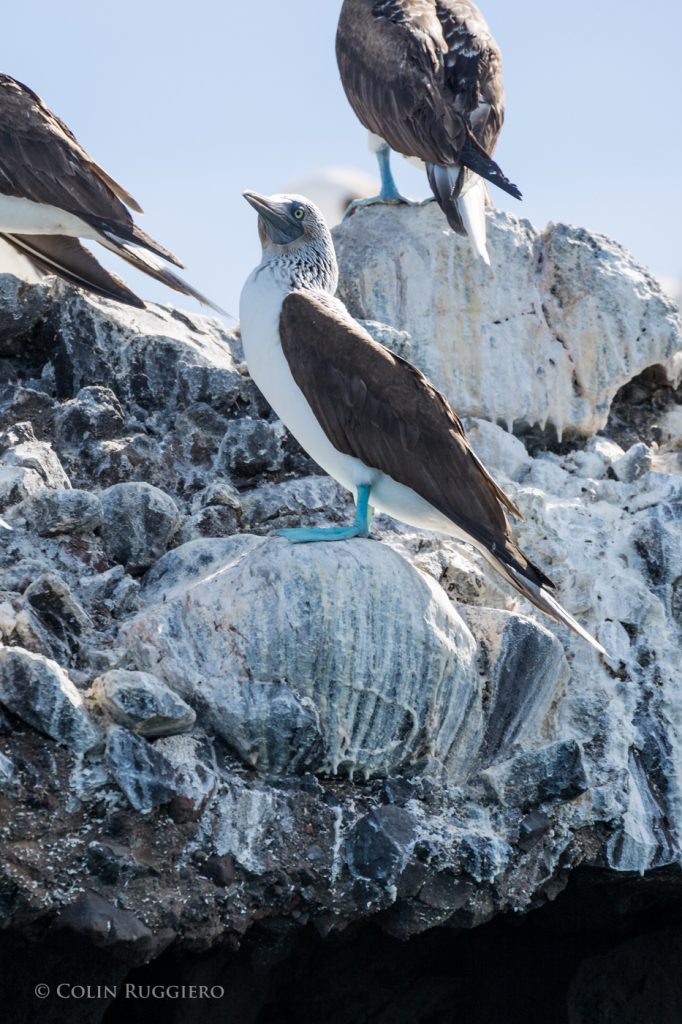
Blue-footed Booby in the Sea of Cortez. Photo by Colin Ruggiero
Possibly, but the males aren’t taking it lying down. They will destroy an egg in their nest if they suspect it was fertilized by another, and if the female was out of their observation range for a few hours or more during the 5 days of fertility prior to egg laying, then they are definitely suspicious. Dr. Drummond and his colleagues tested this by “kidnapping” males during the 5 critical days. Under these circumstances, the males destroyed the first egg subsequently laid, ensuring that they didn’t have to raise some other guy’s chick. If they are kidnapped prior to the fertile period they leave the egg alone. Male boobies will actually abandon particularly perfidious partners, and seek out others to soothe their ruffled feathers. Says Dr. Drummond, “Isla Isabel has roughly 2,000 pairs of Blue-footed Boobies, and at the end of every season half of the pairs break up.”
Before egg incubation starts, nearly all male boobies on Isla Isabel court extra pair females, while roughly one third of the females develop sexual relationships with one or more male neighbors. But booby mates who retain the same partner for successive years definitely reap gene pool rewards – Dr. Drummond has found that they produce 35% more offspring those who change partners. And while all booby couples share in parental duties, longtime mates spend equal time caring for their young. They are completely in it together, with males spending just as much time as their mates on household duties. Female boobies. Has their behavioral long game all along been shaping male boobies into the perfect domestic partner? That would be a remarkable evolutionary feat!
While longtime mates may cohabit harmoniously, harmony is definitely not a word one would associate with their offspring in the nest. Dr. Dave Anderson, Professor of Biology at Wake Forest University, has studied boobies in the Galapagos Islands for most of his adult life. He explains. “Nazca boobies (the Blue-foot’s cousin) only want one chick but they sometimes have two by mistake when their extra insurance egg hatches. In such cases, 100% of the time the older (or healthier) chick will force the other one out of the nest with no parental interference, and perhaps even some parental facilitation. Once out of the nest, a chick has no way to survive on its own. Nazca boobies nest on the ground in such a way that the nest is essentially a gladiatorial arena that the parents observe from on high.”
“The Blue-footed Boobies, on the other hand, do want the option of having two chicks. So they will give the first egg a head start of 3-5 days before laying the second egg, such that a natural dominance hierarchy is established among the resulting chicks. If food is abundant, they will raise both chicks. However, the first-hatched chick fiercely beats up the second-hatched, and the second-hatched survives only by adopting submissive behavior.” Dr. Anderson points out that the parents help the subordinate by building nests that are bowl-shaped, which means that when the older chick is pecking the younger one, at least for the first ten days or so, the poor little guy generally doesn’t fall out of the nest like its hapless Nazca counterpart – there are walls to keep it hemmed in. Further, unlike the murder-permissive Nazcas, murder-restrictive Blue-footed Booby parents will actually sit on their chicks to prevent the dominant from killing the subordinate.
Dr. Anderson tested what would happen when the constraints of the parents and the bowl-shaped nest are removed. “What is really interesting,” says Dr. Anderson, “is when we put Blue-footed Booby chicks in Nazca nests with Nazca parents. They are much more aggressive than when in their own nests. And when we put Nazca chicks in Blue-footed nests with Blue-footed parents, they still want to kill each other but can’t because of the shape of the nest and the murder-restrictive Blue-footed parents.” They may fool around like mad, but the Blue-footed Boobies do draw the line at siblicide, unless of course, food is scarce – as in an El Niño year – and subordinate chick sacrifices must be made.
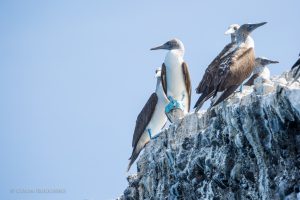
Blue-footed Boobies. Photo by Colin Ruggiero
Now you may well imagine that the poor second-hatch chicks, having been so horribly abused by their siblings and practically starved to boot, would turn into physically stunted adults, emotionally crippled by their circumstances and consigned to a lifetime of failure. “Not so!” says Dr. Drummond. “We compared 1,167 fledglings of two-chick broods for 10 years and found few differences between first-hatched and second-hatched birds. Even more surprisingly, where there were differences these tended to favor subordinates.” By almost every measure that counts in a booby’s biological life, Dr. Drummond found that the subordinate chicks matched or bettered those of their dominant tormenters including survival, defensive ability, brood size, nest success, and cumulative brood size over the first ten years of life. Blue-footed Boobies. Liberated females, progressive males, bullies not allowed to flourish over others. What else can we learn from our blue-footed friends?
Every mating season the Blue-footed Booby males stake out their territories and wait for females to come by and notice them. “The males then fall all over themselves trying to demonstrate their suitability as a mate” says Dr. Drummond. One would think in such circumstances that younger, more virile (and of course bluer-footed) birds, would rule the day. But once again, things are not always as one would imagine in the booby world. Dr. Drummond and his colleagues have found that May-December romances among the boobies, i.e., partnerships in which one bird is old and one bird is young, produce offspring that are significantly more likely to later become parents themselves compared to the offspring of parents of a similar age. And it doesn’t seem to matter which sex is at which end of the age spectrum, old mothers and young fathers or old fathers and young mothers, the results were the same in the 3,361 booby offspring that Dr. Drummond and his colleagues studied – breeding in age-mismatched parents provides greater success in contributions to the gene pool than those of similarly aged parents. In fact, the advantage to the chicks born of May-December parents was almost as great as those conferred on chicks whose parents are in long-term partnerships. Why this is so remains a scientific mystery. Could it simply be that Blue-footed Boobies are as socially evolved as the French?
So now we know that these dancers who looked so silly they earned themselves the name of Booby may actually have some elegant lessons to share across species: 1. A rough start in life need not define your later years; 2. Sharing equally with a long-term partner produces better health for the family; 3. Age does not necessarily define your ability to contribute to society; and 4. Dancing your heart out no matter what you look like to strangers is one of the keys to a successful life. In fact, the future of the species depends on it.
© Copyright Sergio and Bryan Jauregui, Casa Payaso S de RL de CV, 2017
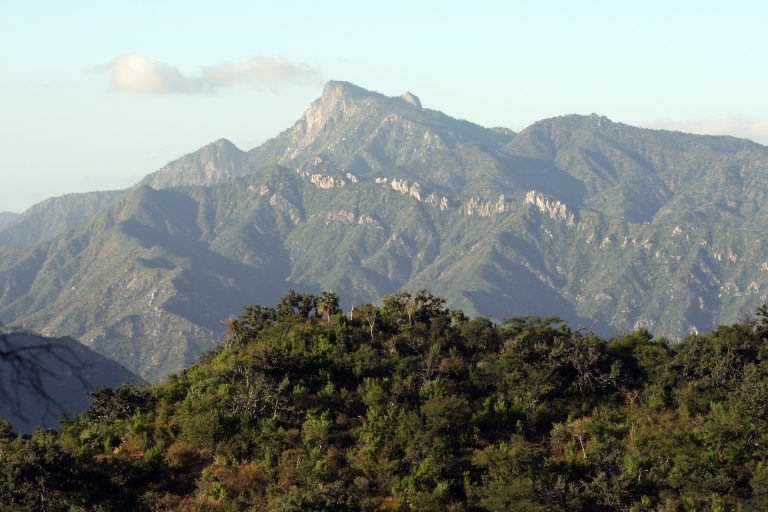
by Bryan Jáuregui | Blog, Conservation, Culture, Education, Plants, Wildlife
by Bryan Jauregui, Todos Santos Eco Adventures
This article was originally published in Janice Kinne’s Journal del Pacifico
Lawyers, guns and money. For the last several hundred years these have been the tools employed throughout the Americas to resolve land use and land ownership issues, and the system continues to thrive in present-day Baja California Sur. If you have enough of all three deployed in the correct proportions, you can generally carry the day. So how could the staff of a resource-restricted, government-operated, conservation-driven institution face down a large multinational company aiming to put an open pit gold mining operation in the UNESCO-certified natural area that they are charged with protecting? If you’re the employees of CONANP (The National Commission of Natural Protected Areas) in Baja California Sur you look to the earth. You invoke the powerful forces of nature. You call in the botanists.
When the CONANP team first met Dr. Sula Vanderplank of the Botanical
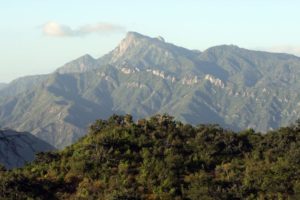
Sierra El Taste.Photo by Jon Rebman
Research Institute of Texas in 2014, she and her colleague Dr. Benjamin Wilder of the University of Arizona and Next Generation Sonoran Desert Researchers (N-Gen; www.nextgensd.com) had just completed a terrestrial biodiversity study of the lands surrounding Cabo Pulmo National Marine Park. Not coincidentally, these were the same lands targeted by a developer with plans to construct a massive 30,000-room hotel complex on the shores of the marine park. While there are likely many factors that ultimately lead to the termination of the project –massive protests, focused effort by leading local and international NGOs, international media scrutiny – it is beyond a shadow of a doubt that the findings of the team lead by Sula and Ben were a strong contributing factor. Why? In the area where they were to construct the hotel the botanists and their bi-national, multi-disciplinary team recorded no fewer than 560 species of flora and fauna. Of those, 100 (almost 1 in 5) are endemic to the Cape region of Baja California Sur, and 42 are on the Mexican endangered species list. Until that time, no one had any idea of the magnitude of the biodiversity of the area. As the authors of the study concluded, “Given the large number of endemic species present in the area, large-scale development projects risk the full scale and local extinctions of endemic species with narrow geographic ranges. Entire species could be lost forever (and their roles within the Sonoran Desert ecosystem) from the unique places where they evolved in situ during thousands or millions of years.”
Development ‘s deadly impact on biodiversity: CONANP was inspired. Gold mines operating in a protected natural area: N-Gen was invigorated. The opportunity to bring serious scientific scrutiny to Arroyo La Junta and the Los Cardones open pit gold mining project: it was too compelling to ignore. The CONANP/N-Gen team of Sierra scientific superheroes was born.
Now fictional superheroes like Bruce Wayne and Tony Stark conveniently come with immense family fortunes to back their earth-saving endeavors. Not so with reality-bound botanists and their colleagues. When Sula and Ben were first introduced to the Arroyo La Junta area in the Sierra foothills where the Mexican government had authorized the Los Cardones mining project, they couldn’t find much science on the area. A good bit of work had been done at the higher elevations of the Sierras, but the area around the proposed gold mine had remained a generally science-free zone. With the help of CONANP, Sula and Ben set out to change that and, as they had done in Cabo Pulmo, created a proposal to bring rigorous scientific investigation and analysis to determine the magnitude of endemism and biodiversity in the area. CONANP was thrilled. Potential funders were silent.

Anti-mine protest in Todos Santos town plaza. Photo by Kamal Schramm
“Then an interesting thing happened” says Ben. “When the government approved the MIA (environmental impact assessment) of the Los Cardones mine, the people of Todos Santos and La Paz rose up in protest and staged rallies and marches against the mine. This public outcry really gave new life to the importance of understanding the potential impact to the biosphere reserve.”
Anne McEnany, president of the International Community Foundation, had been involved in educating people about economic activities in the Biosphere Reserve for years, and immediately grasped the importance of the N-Gen project. “ICF has been working with local organizations to educate and inform the general public about the Biosphere Reserve and the La Paz watershed by developing curriculum, analyzing potential economic activities, and convening workshops. When the N-Gen research team approached ICF to finance a biodiversity assessment there, we knew it was the right next step. How can CONANP appropriately manage such a large area without knowing what is there?” The CONANP team breathed a sigh of relief. The botanists got busy.
Sula came down in September 2015 to scout out the area and to work with the director of the Sierra La Laguna Biopshere Reserve, Jesús Quiñónez Gómez, on the permitting required for the team to conduct its research. The scouting trip a little scary. Recalls Sula, “The Los Cardones people had guards and check points at several spots in the Arroyo La Junta area, and it was definitely a little intimidating. So when we came back with the whole team in December 2015, we were apprehensive about the type of reception we might receive.” The “whole team” consisted of 46 participants, including 29 scientists from 19 institutions (10 from Mexico and 9 from the US). Everyone was a little nervous, but by the time the team arrived to conduct their 8 days of investigation starting on December 4, 2015, the roadblocks and guards had been removed and the team worked without interference.
And apparently without much sleep either! The group, many of whom had worked on the Cabo Pulmo study and are part of the N-Gen network of investigators, consisted of 5 main teams of scientists: 4 botanists (the plant people), 6 entomologists (the insect folks), 8 herpetologists (the snake and lizard researchers), 7 mammologists (self-evident) and 4 ornithologists (the birders). Specialists for each taxonomic group worked almost around the clock, systematically surveying different areas as daytime collections gave way
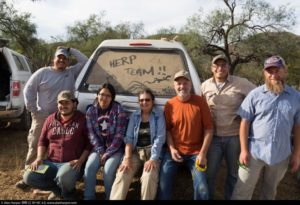
Herpetology Team. Photo by Alan Harper
to nocturnal studies, which in turn rolled into bird surveys underway well before dawn. A CONANP management team of 10 people kept the whole project going, while the Rancho Agua de Enmedio family kept them all well fed, and Niparajá assisted with local logistics.
It couldn’t have been more perfect: a CONANP-inspired, ICF-funded, N-Gen-executed project with a multinational team of scientific rock stars to assess the biodiversity of an area that has been consigned to the ravages of open pit gold mining. It is the people of Baja California Sur’s dream team, and if ever salvation were at hand, it is now. But “now” is December. The rains of summer are but a distant memory so few annual plants persist, and the perennials are not sporting many of their distinguishing flowers and fruits; the botanists are challenged. The weather is cool and the cold-blooded snakes are not inclined to come out; the herpetologists find solace in the amphibians. There’s water in the arroyo so land mammals are around, but volant mammals (AKA bats) are the least likely to be active in the Sierras in December; the mammologists scan the night skies with few catches. Aquatic invertebrate communities often show great seasonal variability, and there are substantial taxonomic limitations to larval identification; the entomologists take pleasure in the huge number of harvestman spiders around that freak out all the other scientists. Lots of birds are in residence, but several important species frequent the Cape Region only in summer; the ornithologists make do with what they have.
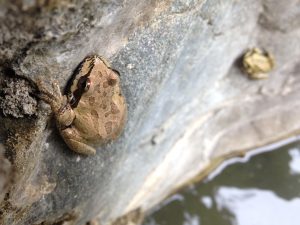
Baja California Sur Tree Frogs. Photo by Michael Bogan
All of which makes it even more impressive that in the 500 hectares (1,235 acres) of land currently petitioned for use as the Los Cardones open pit gold mine project, the N-Gen team found 877 (eight hundred and seventy-seven!) species of flora and fauna, including 107 species endemic to the Cape Region alone, and 29 species listed as endangered by the Mexican government. Not only that, entirely new species were documented, including 2 insect species (and possibly more), and a completely new plant species record for the entire Peninsula, Brickellia diffusa, part of the sunflower family. And given the limitations of their research – they only had 8 days at a relatively unproductive time of year – the results are all the more astounding. In fact, the scientists reckon that their study represents only 25% (invertebrates) to about 50% (reptiles and amphibians) of the total species present in the region. It’s the frickin’ Garden of Eden on a 500 hectare lot.
But everyone knows that the Garden of Eden comes with a fast-talking serpent (apologies herpetologists) who doesn’t have the happiness of mankind at heart when he offers temptation to the innocent. As Exequiel Ezcurra, Director of the California Institute for Mexico and the United States (UC MEXUS) and co-editor of the study writes in the introduction to the soon-to-be-published study, “At the end of ten years of operations, the Los Cardones mine would have extracted about 173 million tons of rock, 135 million of which will have been deposited as waste in large pilings, and 38 million tons will have been accumulated in tailings in the form of sediments saturated with cyanide solution. In those ten years the project would have consumed about 300 million kilowatt-hours from the local power grid, releasing about 150,000 tons of CO2 into the atmosphere generated by the consumption of about 100 million liters of fossil fuels. In return, the project would generate only about 200 jobs for the entire region and only a meager eight tons of gold for the benefit of a private company.”
Scarier still, like the Garden of Eden, Arroyo La Junta is bounded by rivers, and its tributaries lie along the division of two watersheds. The ridge just to the north of Arroyo La Junta demarcates the boundary where water flows to the La Paz watershed, ending in the Gulf of California. Arroyo La Junta itself flows towards Todos Santos and empties into the Pacific Ocean. As Exequiel writes, “The mining project Los Cardones….plans to extract gold at the headwaters of the La Paz watershed treating the extracted rock with tons of cyanide, an amount sufficient to kill the entire population of Mexico.” Everyone on the peninsula knows that just one big hurricane could release a disaster of untold proportions from the mining site – it’s already happened in Sonora.
Of course it is the water that is the very source of the incredible biodiversity of Arroyo La Junta. The aquatic organisms that the water supports attract a vast array of predators like bats, birds and spiders, and the huge number of insects attracts reptiles and amphibians like frogs, who in turn attract larger predators like raccoons and coyotes. The arroyo is not just a source of drinking water for many of these species, it forms the actual basis for regional biodiversity. The humid air and damp areas extend the active period for many species, most especially reptiles, which means that they can extend their ecosystem functions for a larger part of the year.
CONANP discussed the study’s results. “When a company arrives to undertake a project in a protected area, the government wants to know if the project is compatible with the
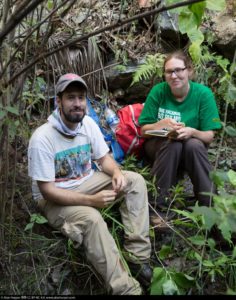
Dr. Benjamin Wilder and Dr. Sula Vanderplank at Arroyo la Junta. Photo by Alan Harper
mission of that area. In this case, the protected area is the Sierra La Laguna Biosphere Reserve, and the mission of CONANP is to protect its biodiversity for future generations. The results of this study reaffirm that mining is incompatible with that mission. The mining company says that it can restore everything as it was after it digs these huge holes in the earth, but this study proves that restoration would be extremely difficult, if not impossible.” Ben is more direct. “The biodiversity numbers of the mining company’s MIA (environmental impact assessment) don’t even come close to what we documented. Restoration to what we see today after 10 years of mining would be impossible.” Exequiel agrees. “…we want to remind ourselves again, extinction is forever; our children will never be able to see the species that our generation pushes to oblivion.”
Lawyers, guns and money. In some cases these tools bring clarity, but in others they are employed to obfuscate, intimidate and renumerate away obstacles. And therein lies the beauty of the N-Gen study – it is pure, crystal clear, science. Every fact fully documented and not subject to dispute. And the timing could not be better as there is now a precedent for scientific institutions setting environmental parameters for mining operations. On February 8, 2016 Colombia’s Constitutional Court repealed Article 51 of the National Development Plan that had allowed the Environmental Licensing Authority to authorize mining projects in the Andean paramos, tropical alpine ecosystems. It ordered the Ministry of the Environment to use the map created by a scientific research institute, the Alexander von Humboldt Institute, as the basis for demarcating the boundaries of the paramo habitat. As Exequiel writes, “This was the first time a country had so explicitly put the human right to a safe water supply above the interest of big mining companies. It was also the first time that a nation had given such importance to a scientific research institute in the decision making process.”
Arroyo La Junta is in the part of the Sierras that was designated a Biosphere Reserve by the Mexican government in 1994 and by UNESCO in 2003. So the area’s value has long been suspected, but now, because of the inspiration of the CONANP team to bring in the scientific star power that is the N-Gen network, the true natural wealth of the area has finally been documented and all the players know exactly what is at stake: “Hundreds of species, many of them rare and endemic, others new to science or yet to be described.” The incredibly high rate of endemism is a result of the extreme isolation that the Sierras enjoyed for possibly millions of years. It is the natural heritage of the Mexican nation, and the very source of life for the residents of the Baja California peninsula. All the gold, all the lawyers and all the guns in the world cannot replace it. The botanists showed us that.
Study Findings:
| Group |
No. Taxa |
Endemics |
NOM-059
Endangered Species List |
| Plants |
381 |
77 |
2 |
| Insects |
366 |
15 |
0 |
| Reptiles & Amphibians |
24 |
6 |
16 |
| Mammals |
29 |
3 |
2 |
| Birds |
77 |
6 |
9 |
| TOTAL |
877 |
107 |
29 |
Participating Institutions:
| Mexican Institutions |
US Institutions |
| @Lab |
Botanical Research Institute of Texas |
| CIBNOR |
Next Generation Sonoran Desert Researchers |
| CICESE |
Orma J. Smith Museum of Natural History, The College of Idaho |
| CICESE, Unidad La Paz |
San Diego Natural History Museum |
| CONANP |
San Diego State University |
| Fauna del Noroeste |
San Diego Zoo Global |
| Niparja |
Sky Island Alliance |
| Rancho Agua de En medio |
University of Arizona |
| Terra Peninsular |
University of California, Santa Cruz |
| University of Guadalajara |
|
Vanderplank S, BT Wilder, E Ezcurra. 2016. Arroyo la Junta: Una joya de biodiversidad en la Reserva de la Biosfera Sierra La Laguna / A biodiversity jewel in the Sierra La Laguna Biosphere Reserve. Botanical Research Institute of Texas, Next Generation Sonoran Desert Researchers, and UC MEXUS. 159 pg.
The study will be published in June 2016, and you will be able to find it on the N-Gen web site at www.nextgensd.com.
Todos Santos Eco Adventures operates trekking and cultural programs in the Sierra La Laguna Biosphere Reserve, working with local ranchers and their families. For more information please visit www.TOSEA.net
© Copyright Sergio and Bryan Jauregui, Casa Payaso S de RL de CV, 2016
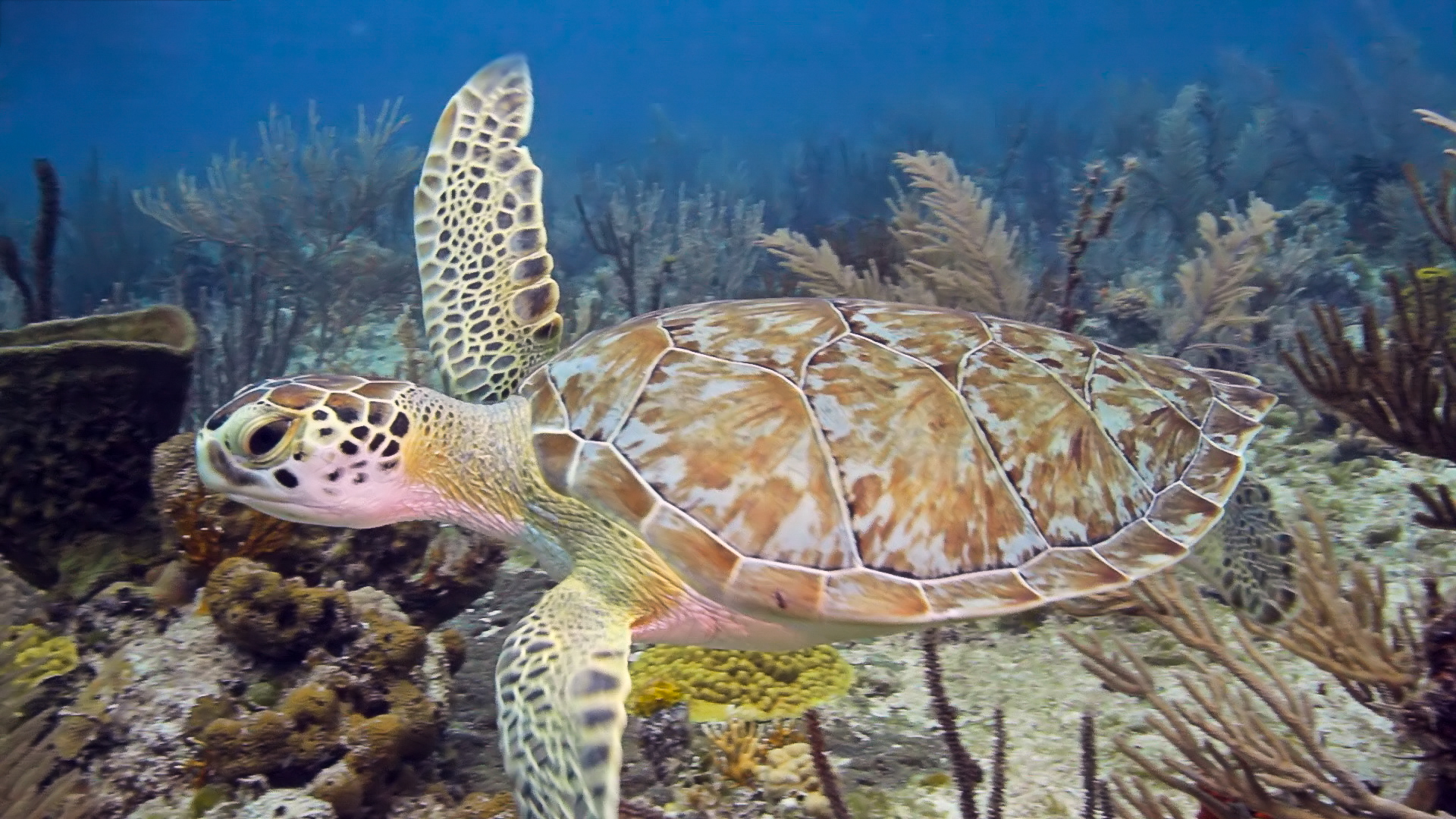
by Bryan Jáuregui | Adventure, Blog, Education, Wildlife
by Bryan Jauregui, Todos Santos Eco Adventures
This article first appeared in Janice Kinne’s Journal del Pacifico
If they had a World Championship for Insult Hurling, China’s entry of “Son of a Turtle!” may not seem like obvious prize material. But a review of sea turtle reproductive habits reveals why the insult might be a contender: A female sea turtle will mate with several males prior to nesting season, storing the sperm of all her paramours in oviducts separate from her eggs for extended periods of time – sometimes years. When the time is right for nesting, her body will allow the sperm to fertilize the eggs, resulting in what scientists like to call “multiple paternity” for her offspring. In other words, little baby sea turtles have no idea who their daddies are. Get it?
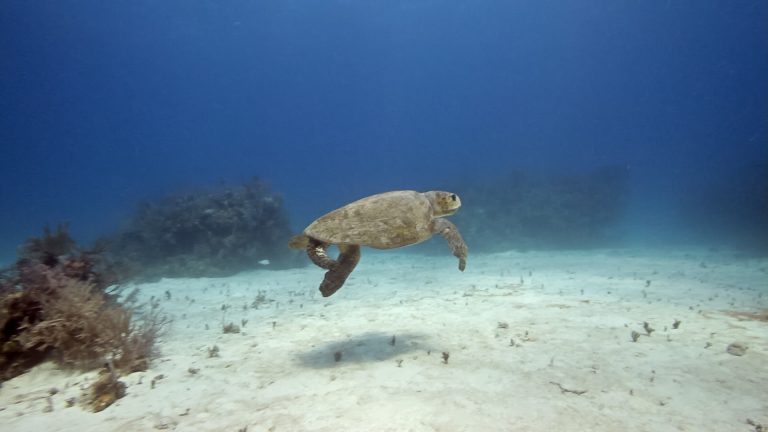
Loggerhead Turtle. Photo by Colin Ruggiero
(more…)


 For its part, the lesser long-nosed bat (Leptonycteris yerbabuenae) may migrate only a few hundred miles each year from south-central Mexico to Baja California Sur, but the females of the species up the ante by doing it while heavily pregnant. According to Dr. Winifred Frick who has studied the bats of Baja for almost two decades, “In late March and early April the females follow the nectar corridor north from southern-central Mexico up along the Sinaloan coast, and we think they likely fly over the Sea of Cortez to the Baja peninsula. The lesser long-nosed bats are in the last stages of pregnancy when they make these spring migrations. Their feat is made all the more incredible when you realize that bat pups are roughly a third of the mother’s weight at birth – an enormous amount of extra baggage to carry on the migration route. The females then all give birth at the same time in mid-April in what is known as a synchronous birth pulse.” (It is generally acknowledged as a blessing that the migratory homo sapiens do not follow suit.) The babies nurse for 4-8 weeks, during which time it is not unusual for the mothers to fly 60 miles in each direction, each night, to their feeding grounds to obtain the nutrition needed for both mother and pup. Dr. Frick puts this feat into human terms. “It would be like leaving your newborn at home, jogging 60 miles to find a pop-up grocery store, eating all your meals at once, then jogging 60 miles home to your newborn.” In the process of feeding, the lesser long-nosed bats act as major pollinators for Baja California’s agaves and columnar cacti. When the cacti are pollinated and the babies are weaned, the cloud of bats then migrates back to the Mexican mainland. A very satisfactory migration job completed!
For its part, the lesser long-nosed bat (Leptonycteris yerbabuenae) may migrate only a few hundred miles each year from south-central Mexico to Baja California Sur, but the females of the species up the ante by doing it while heavily pregnant. According to Dr. Winifred Frick who has studied the bats of Baja for almost two decades, “In late March and early April the females follow the nectar corridor north from southern-central Mexico up along the Sinaloan coast, and we think they likely fly over the Sea of Cortez to the Baja peninsula. The lesser long-nosed bats are in the last stages of pregnancy when they make these spring migrations. Their feat is made all the more incredible when you realize that bat pups are roughly a third of the mother’s weight at birth – an enormous amount of extra baggage to carry on the migration route. The females then all give birth at the same time in mid-April in what is known as a synchronous birth pulse.” (It is generally acknowledged as a blessing that the migratory homo sapiens do not follow suit.) The babies nurse for 4-8 weeks, during which time it is not unusual for the mothers to fly 60 miles in each direction, each night, to their feeding grounds to obtain the nutrition needed for both mother and pup. Dr. Frick puts this feat into human terms. “It would be like leaving your newborn at home, jogging 60 miles to find a pop-up grocery store, eating all your meals at once, then jogging 60 miles home to your newborn.” In the process of feeding, the lesser long-nosed bats act as major pollinators for Baja California’s agaves and columnar cacti. When the cacti are pollinated and the babies are weaned, the cloud of bats then migrates back to the Mexican mainland. A very satisfactory migration job completed!




















